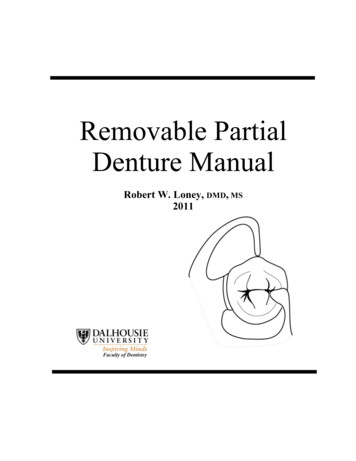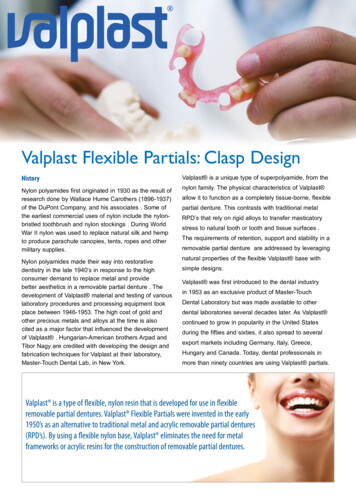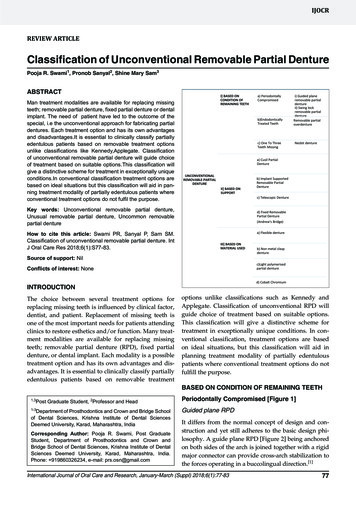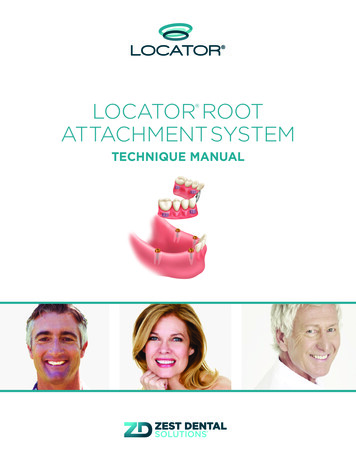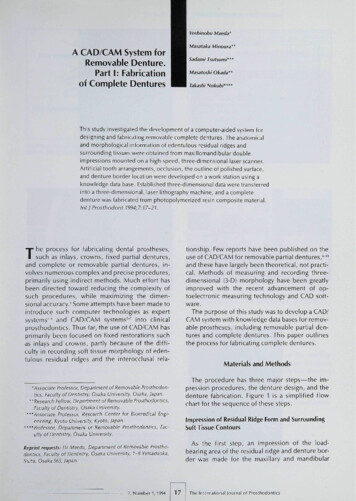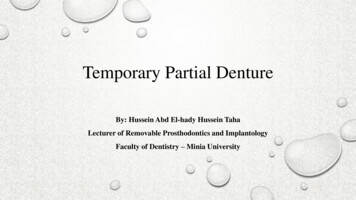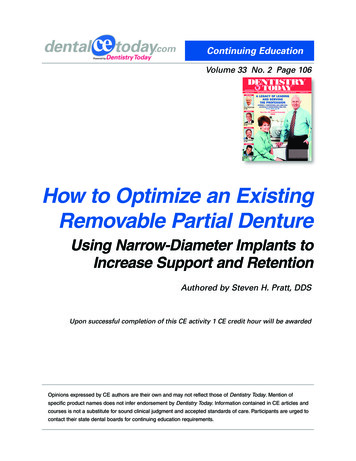
Transcription
REMOVABLETHERATIONALEPARTIALDENTURESOF PARTIALDENTURECHOICEOLIVER C. APPLEGATE, D.D.S., D.D.Sc.*Universityof Michigan, School \ of Dentistry, Ann Arbor, Mich.for restoring the partiallyC lous dental arch involves borderline decisions.Often, a complexityedentuof oralconditions may exist, regarding which decisions ultimately must be made. In addition, partial denture design is complicated by the many possible combinations ofthe remaining teeth, so the making of a choice in restorative procedure may become disconcerting.Prosthodontists have been tolerant of a poorly organized approach to thisproblem. Sometimes, little logic is used in arriving at a selection of prosthetictreatment for the varied semiedentulous situations. The resulting uncertainty oftenhas caused dentists to delegate responsibility in designing the removable partialdenture.With caries control methods not having gained nationwide -application, manybroken dental arches will continue to need partial denture service. Indirectly, modern periodontic treatment has also been responsible for a steadily increasing demandfor partial denture service. Many periodontally involved teeth are returned to acondition of health for patients already partially kdentulous. Formerly, most ofthese teeth would have been extracted. These patients will have been told, ,antlrightly, that the missing teeth’ must be replaced at once to protect the results already achieved by occlusal equilibration and periodontal therapy.Thus, a future load of increasing need for partial dentures is confronting dentistry. Much of this required service can be supplied only by the general pm&tioner. This prospect indicates an urgent need ‘for clarification of at least thosepartially edentulous situations which are found repeatedly in clinical dentistry. Theindications and contraindications for va\rious restorative procedures should bebetter correlated with the principles of removable partial denture design so as tobe successfully applied by a dentist with less than specialist training in prosthodontics.HOOSINGONEOF THEPOSSIBLEPROCEDURESRead before the Academyof De&u-eProsthetics,Loufsville;Ky.*Professorof Dentistryand Directorof PartialDentureProsthesis,KelloggInstituteof Graduateand Post-graduateDentistry.891Schoolof Dentistryand
892Fig.J. Pros. occursclass I condifion.OF lassificationin removable partial denture prosthesisshould be specificallyrelated to oral conditions. In the past, classification has been restricted only to thedesignation of vacant spaces in the dental arch. Actually, the size of edentulousspaces, even the location of remaining teeth, are secondary in diagnostic significanceto the condition of the supportive structures. Other factors1m4 have much more important bearing oti what should be done prosthetically than the number, or even thelocation, of the remaining teeth. Of these factors, only the most important will bediscussed.Bone Maintenance Potential.-Thecapability of the patient to replace boneelements as rapidly as they are used is at the top of the list of desirable conditions.A physical examination which accurately evaluates the systemic condition may benecessary. However, good roentgenograms of the complete alveolar process usuallywill give a dependable index as to the patient’s potential metabolic function as itaffects bone maintenance.Fig. 1, B and C.-Thebone maintenanceis exceptionallygood, consideringthe longof the abutmentsand that the patientis nearly70 years of age. Note the extremeatrophyticularlyin A,) in the posterioredentulousridges.service(par-
Volume 10Number 5THERATIONALEOFPARTIALDENTURECHOICE893The ability of the patient to tolerate prostheticallyinduced stress loads isdirectly related to his past record of alveolar bone maintenance in areas of hyperfunction. Such dependable index regions of alveolar bone exist around teeth thathave served as abutments, inclined teeth, teeth adjacent to edentulous spaces andwhich are in occlusion, and teeth in traumatic occlusion. The exception to this ruleis in the patient who has undergone physical changes which would interfere withhis metabolic function. Any restoration of masticatory function, to be more thantemporary, must be attuned to the patient’s evident ability to maintain alveolar bow.Previous Cervical Bone Loss.-Evenwhen a morbid metabolic function hasbeen returned to a normal level, some permanent bone loss may have occurred. Theextent of prosthetic load which may be safely allocated is then affected. The occlusalstresses are magnified since the extra-alveolarsegment of the abutment tooth hasbeen lengthened by cervical bone loss. This is not to say that such teeth cannotfunction as abutment teeth, but it does materially affect the type of mouth prepara.tion and the choice of restoration.A.B.Fig. 2.-A,The lower left bicuspidshave carrieda very heavy occlusalload for many years.The patientis a vigorous,healthyman, about 42, able to exert exceptionallyheavy bitingforces.Note the excellentbone maintenance.In spite of this, a carefullyconstructedclass II partialdenturebase carryingthe molars showeda loss of stabilitywithina short time. This is a corn.mon examplethat even when there is normalalveolarbone there may be atrophyin the unusedsector of the same dental arch. B, The boundarytooth in a class I situationmay need extensiverestoration,or often it may not be able to serve alone as an abutmentfor the needed extensionrestoration,but by union with an adjacenttooth adequateabutmentservice can be provided.Abutment Root Form, Length, a.nd Stability.-Thenext most critical influence in recovery of the patient’s dental facilities is the anatomic condition of theprospective abutment teeth. The length of the root determines the intra-alveolarsupport which can counteract the extra-alveolarstress or the work portion of thelever arm.
894J. Pros. Den.Sept.-Oct., 1960APPLEGATEForm of the abutment root is important, because if the root tapers sharply, anyprevious cervical loss of bone is doubly significant. The amount of the remainingalveolar wall which supports the abutment load is reduced rapidly when the rootis steeply tapered. Such roots can be used for abutment support only when definitemeasures have been taken to supplement the abutment function. The splinting oftwo or more adjacent teeth is the most dependable solution in this situation.Extent of Periodontal Involvement .-The degree of lateral mobility of an abutment tooth is of lesser clinical significance. Unless there also has been serious periodontal damage, the tooth will recover its previous firmness. However,this recovery depends upon the alleviation of the local predisposingconditions whichproduced the excess mobility in the first place.Fig. 3.-Theseclass I partialdentureshave resin bases, but frequentlythe base is made ofcast metal. The lower denturehas a linguoplatetype of majorconnector.This maxillarypartialdenturehas a posteriorpalatal bar. This unit may be omittedIn some cases.Mobility of teeth is reason for careful investigationdegree of recovery of the cervical bone is dependent upongenie tissues. The restorative program must be plannedteeth are effectively stabilized to achieve bone regeneration.the splinting of adjacent teeth.of the areathe vitalityso that theFrequently,because theof the osetotraumatizedthis requiresCaries Susceptibility.-Extremecaries susceptibility is a factor in making thechoice between complete and partial denture service. Once the decision to retain theremaining teeth has been made, caries susceptibility is related to the type of toothrestoration to be supplied. Even though the patient may have shown complete cooperation in the exercise of caries control measures, with a satisfactory reductionof the bacterial count, complete crown coverage is indicated as a further protectionagainst recurrent or new carious lesions. This creates a problem in esthetics whenanterior teeth are to be restored, and, therefore, is a factor to be considered constantly in oral rehabilitation.Size and Form of the Residual Ridge.-Thesubbasal support is a controllingfactor in the choice of a partial denture, as it also may have been a potent reason
EEr t5”THERATIONALEOFPARTIALDENTURECHOICE8?5for not rendering complete denture service in the first place. If the ridge form is extremely poor (low, flat, and with reduced surface for support),adequate stresscontrol will be a serious problem. Not only will this influence the choice of the typeof restoration, but also the mouth preparation and the design of the appliance w:illneed modification to meet possible magnified stresses. Stress control will becomean acute problem when the mandibular ridge must support a restoration afterlengthy disuse of the posterior edentulous areas.Location of the Remaining Teeth.-Thelocation of the remaining teeth ismore important in partial denture construction than the number of teeth that areleft. Root form and length, number of roots, crown form, form and bulk of thesurrounding alveolar process, and the location of the remaining teeth in the dentalarch are factors which are rated well above mere numbers.CLINICALCLASSIFICATIONOF PARTIALLYEDENTULOUSSITUATIONSA removable partial denture classification means little or nothing unless italso has clinical application. To say that the same type and design of partial dentureis indicated in each situation where the same teeth are missing is to presume tkctoral conditions never vary. To presuppose that the potential abutment teeth andtheir supporting structuresare equally capable where the same teeth have beenlost is equally unrealistic.Thus, it is improper to delegate (withoutproper instructions)the importantstep of designing the removable prosthesis to a laboratory technician. He mustdepend entirely on the cast, which shows only that certain teeth are missing. Thispractice is vulnerable because it completely disregards the adequacy of the oralstructures to provide support. Planning and designing the removable partial denture must be done by the only person who can evaluate the oral condition-theex’anzining dentist. The province of the laboratory technician is to produce, but notto prescribe, the prosthesis.In choosing a basis for a classification, we should seek one which is fundamental. Nothing is more essential than achieving support for the needed prosthesis.The longevity and comfort of the denture is most dependent upon this factor.A classification system, to be applicable, must completely correlate with oralclinical conditions. The system also must be closely integrated with restoration design so that practical measures can be applied to keep induced stress loads withinphysiologic limits.Six groups or classes are required to correlate the situations in semiedentulismand the conditions which are most commonly associated with each group. The proposed method is a classification of partially edentulous conditions based upon (1’1the ability of the boundary teeth and their supporting structures to supply abutmentfacilities for the needed partial denture and (2) the location of the edentulous spacesin relation to the teeth which remain1CLASSIClass I representsan edentulous situation in which all remaining teethare anterior to the bilateral edentulous ridges (Fig. 1A). This is the most frequently
896APPLEGATEJ. Pros. Den.Sept.-Oct., 1960A.B.c.Fig. 4.-A,An exercise prosthesisis used to reconditionthe regionsof alveolardisuse beforeplacinga functionalload on the depletedridges. Note the maximumtissue coverageof the bases.B, each base has been coveredwith autopolymerizingresin. This restorationis worn for from 3to 5 monthswithoutteeth. Duringthis time the patientbites rapidlybut lightlyon a fingerplaced on the base near the abutmenttooth of each side. This exerciseis repeatedfrequently.Also, the patientalternatelyretainsmouthfulsof hot and cold fluids to induce thermalstimulation. C, The restorationhas been completedwith the teeth placed in a bakncedocclusalrelationship.Note the narrowedocclusal surfaces.
97occurring class, and its highest incidence is on the mandible. Often, the poster!orteeth have been missing for many years.The conditions commonly associated with class I are : ( 1) six to ten anter:.orteeth remain (Fig. lA), (2) the boundary tooth may not be capable of unaidedabutment function (Figs. 1, B and C, and 2, BJ, (3) resorption of the residual ridgeis seen in varying extent (Fig. 1, A and C), (4) the immediate stability of the edentulous sector depends largely upon the period of disuse (Fig. 1, A-rightside ofclass I arch--and C), (5) the ultimate stability of the residual alveolar bone is proportional to the ability which the patient has shown in maintaining the bone structure (Fig. 2), (6) malposition and irregularityof the remaining teeth may haveand(7)reducedinterarchspace often existsresulted from their migration,posteriorly.The removable prosthesis for class I permits no choice; it must be an extension-base partial denture of bilateral design (Fig. 3). Often, because of extensivedisuse atrophy (Fig. 2), the use of the appliance without occlusal function as an“exercise prosthesis”is indicated (Fig. 4) . This is especially beneficial when anopposing complete denture must be used. The available subbasal support givesthe maxillary denture a great advantage over the lower partial denture. Reconditioning the alveolar structure of the mandible first materially reduces this disadvantage.The greatest variance in class I removable partial dentures is in mouth preparation. Splinting of adjacent teeth allows subnormal teeth to be retained whenthere is lowered physical tolerance, previous cervical bone loss (Figs. 1, B and IL’,and 2, B), or periodontal damage. In spite of such aid, the occlusal load often needsto be reduced when both tooth and ridge support are subnormal. Many class Identures require reduced width of the teeth.3 While this decreases the masticatoryload, it will not lessen the stresses generated in brusism. Only one point of occlusal contact is needed to transmit the occlusal force when the teeth are clenched.However, the occlusal forces are materially lessened by following the proper procedure in attaining harmonious occlusion first of the remaining teeth5 and laterof the artificial teeth.4Class I conditions have occupied most of the attention of dentists in partialdenture prosthesis. This situation will gradually change as more posterior teeth arereconditioned endodontically and periodontally to increase the frequency of toothborne (class III) restorations.CLASSIIClass II situations are those in which remaining teeth of either the rightor left side are anterior to the unilateral edentulous ridge (Fig. 5). The associated conditions of class I also may occur in a class II group. However,almostinvariably, another characteristic is found in class II. Since all teeth remain on oneside of the arch, the patient experiences less noticeable impairment of mastication.This makes him less inclined to seek replacement of the missing teeth until muchdisarrangement of the remaining teeth has taken place.
898J. Pros. Den.Sept.-Oct., 1960APPLEGATEBecause of this common occurrence, certain characteristicsoccur in additionto those noted for class I situations:(1) more disuse atrophy of the residual ridgeis likely, (2) extrusion of the opposing teeth often is more extreme, (3) the alveolar process may have accompanied the occlusal movement of the teeth (Fig. 6)) (4)extensive restoration of the opposing teeth is frequently necessary because of theirocclusal disarrangement,(5) extraction of teeth which show extreme movementin the occlusal direction may be necessary, and (6) temporomandibularjoint disability is more frequent in long-standing class II situations than in class I.Replacement of unilaterally missing posterior teeth has often been neglected.Some patients who develop a temporomandibularjoint syndrome report that norecommendation for replacement was made when their teeth were extracted.A unilateral loss of posterior teeth induces occlusal imbalance and deflectiveocclusal contacts. Occlusal equilibration is temporary unless the missing teeth arereplaced and occlusal balance is also achieved in the region of the missing teeth.Class II patients generally are more able to maintain the alveolar processes.This may be the reason that the teeth of one side have been retained. There is lessneed to splint adjacent teeeth for multiple-abutmentsupport than in class I situations. As with the class I restoration, there is little choice as to the type of removable partial denture. The extension base (Fig. 5) is mandatory because, unilaterally,no posterior abutment support remains.A.B.Fig. 5.-Teethare missingposteriorlyonly on one side of the arch in the class II situation.The metal base is used in the maxillaryarch more frequentlythan for lower partialdentures.Rebasinga maxillarybase is not often necessary,because resorptivechange is seldom encountered in a maxillaryarch. For this reason, the use of an exerciseprosthesisis not requiredformaxillaryremovablepartialdentures.The problemof disuse atrophyis almost completelylimited to the mandibulararch.Occasionally, when posterior teeth have been lost, some portion of thefunction is replaced with a fixed prosthesis. This is done by splinting twoadjacent teeth to support a fixed cantilever, distal extension. The methodmore often in class II but has been used bilaterally also. There is dangerocclusalor threeis usedin this
Volu1ne 10Number 5THERATIONALEOFPARTIALDENTURECHOICE 99practice. Destructiveleverage is developed by such restorations.The restorationmay seetit to be satisfactory ; however, should there be a physical decline for anyreason, irreparable damage may be caused before any symptoms are noticeableclinically.In addition, the residual ridge beneath the cantilever occlusal surface receivesno stimulation and disuse atrophy occurs. Should this continue, the loss of ridgeFig. B.-Extrusionof unopposedteeth is a conditionwhich usuallyoccurs more rapidlyandto a greaterdegreein the maxillarydental arch. Often the alveolarprocess followsthe toothas it moves occlusalward.It is not uncommonto see an occlusalsurfacetouchingthe pad ofridge-coveringtissue. It may be necessaryto extractperfectlygood teeth which have migratedto such extremepositions.height may be considerable and the disuse renders the bone unstable. Further resorption will occur beneath a complete-denturebase if one is needed later. Occlusalimbalance follows. The use of fixed cantilever restorations for class I and class IIsituations is to be condemned.CLASSIIIClass III situations are those in which an edentulous space (Figs.7Aand 7B) is bounded by teeth both anteriorly and posteriorly.A distinguishingcharacteristicis that one or more boundary teeth are unable to assume the totalabutment support of the prosthesis. These weak abutments require the aid of otherremotely located teeth, allowing the principle of cross-arch splinting; to be utilizedto resist lateral tilting forces (Figs. 7C and 70).An occlusal stress load has two principal components of force\ one directedvertically, the other inclined laterally. The boundary teeth are not cap’able of assuming the lateral stress in class III situations because (1) the edentulous span islong, (2) the abutment root form or length is unfavorable, (3) the cervical boneis depleted around the abutment teeth, and (4) the occlusal load is excessive.
900J. Pros. Den.Sept.Oct., 1960APPLEGATEFig.7A.A &lateralfixed or removable partial denture would probably fail becauseof inadequate protection against forces which produce lateral tilting. Zones of impingement of the periodontium would follow which might easily exceed the tolerance level of the patient.A class III condition may involve the need for support from more than onetooth at each abutment site. When a combination of impairments is noted, the needfor splinting of abutment teeth is apparent. However, the use of a bilateral designis necessary even when adjacent teeth are splinted together.Fig.7B.Figs. 7A and 7B.-Roentgenogramsshow the typicalclassbound the edentulousspaces are unableto assume the completevertical)which abutmentservice would exert upon them.III situation.stress loadsThe(bothteeth w ,hichlateraland
01Effective endodontic and periodontic therapy will save many molar abutmentteeth, and therefore, more tooth-borne class III partial dentures will be needed,with a reduction of those in class I or II. These molar teeth, although weak oreven mobile, can support the vertical load so long as the trajectory of the force isaxial in its application. 2,6 The infreqtent failures of fixed partial dentures that cyanbe traced to overload are due to lateral, not vertical, stress loads. The removabletooth-borne prosthesis which is carried to the opposite side of the dental arch hasFigs.splinting.but willprecision7C and 7D.-TwobilateralWiththiseffectivecontrol,showa markeddecreaseinattachments.The designin DFig.7C.Fig.711.designsare usedto accomplishthenecessarycross-archtheseteethnot onlycan servesuccessfullyas abutmentsmobility.The removablerestorationin C is retainedbyhas directretainersof the clasp type.a leverage advantage against lateral tilting forces which is very effective (Figs. 7Cand 70). The use of it makes a class III bilateral design so beneficial that mobileteeth may be expected to become firm and remain so when their environment isotherwise made favorable.Two other advantages of the tooth-borne prosthesis over the extension-base,tissue-borne type are important. An occlusal load transmitted via a tooth reaches
902J. Pros. Den.Sept.-O&, 1960APPLEGATEthe supporting bone through the principal fibers of the periodontal membrane asthey are stretched from a relaxed to an extended state. By contrast, occlusal loadsfrom an extension-basepartial denture are transferredthrough its base to themucosa and, by compaction of this pad of tissues, on through to the subjacent bone.This process is often accompanied by trauma from overload and possible prolongedinterference with circulation (as in bruxism) .A class III prosthesis employs a safer, more physiologic method of transferring stress incident to occlusal pressures .2 In addition to this protective measure,another important safety mechanism operates involuntarilyto protect the toothborne restoration against overload. The periodontal membrane has rich proprioceptive (sensory)innervation which is thought to be absent from the mucosal structures. By this control, an involuntary reduction of occlusal forces is effected beforethere is actual realization of pain or discomfort. Hence, the periodontal membraneis protected, but the ridge covering is not. Perhaps this is one explanation of theexcellent record of long service that tooth-borne fixed partial dentures have given.A.B.Fig. 8.-Thefour incisorsare supportedby the ideal cuspid abutments.Note that the arcbetweenthe abutmentsis not severe.When the arch form is such that the arc becomesunfavorable,the abutmentload may be made excessivebecause of the resultingleverage.In thissituation,the adjacentbicuspidsmay be includedin the abutmentsupportby a splintunionto form a multipleabutment.When the anteriorclass IV situationextendsposteriorlybeyondthe cuspid, a removableprosthesisis usuallyindicated.(Courtesyof Prof. F. B. Vedder,Universityof Michigan,School of Dentistry.)CLASSIVClass IV situations are those in which the edentulous space lies anteriorto the remaining teeth which bound it both to the right and left of the medianline. This class is frequently exemplified by a loss of two or more of the incisors.The loss of one or both cuspids in addition to the incisors is less often encountered.Occasions when the anterior edentulous condition extends to include posteriorteeth are infrequent.When the space ends with teeth which can serve dependably as abutments(the cuspids are good examples), the prosthesis most often is of the fixed type (Fig.8). This is somewhat less likely when the lateral incisors are the terminal teeth.Occasionally, when the arch form is such that it does not project anteriorly in an
Volume 10Number 5THERATIONALEA.OFPARTIALDENTURECHOICE903B.Fig. 9.-A,A class IV situationnot only includesloss of the lower incisorsbut much of thealveolarprocess of the anteriorridge. The use of a fixed restoration(such as in Fig. 8) presentsthe diacultyof estheticallyplacingthe pontic units. As a result of such bone loss, from accidentor disease, a removableprosthesisusuallyis necessaryso that a bulk of resin may be addedto supportthe lip for a pleasingfacial contour.If the patientalso has a prognathicrelationship,there is anotheradvantagein using a removableprosthesis.With the cuspid abutmentsweakened by the labial loss of bone, they might become overloadedby the anteriorlydirectedprsognathic stress load. By extendingthe design posteriorly(B) the supportof all remainingteeth jsenlisted to counteractthese forces.arc, a fixed prosthesis may even be preferred when the terminal teeth are first bicuspids. In such extreme use of the fixed partial denture, multiple-abutmentsupport is necessary.There are instances where the class IV situation calls for a removable prosthesis even when the restoration could be supported satisfactorilyby the boundaryteeth : ( 1) when excessive loss of alveolar bone (as in an accident or disease) requires a bulk of resin to support the facial structures(Fig. 9), (2) when supportand retention must be gained from more and/or better abutment teeth, and (.3)when wider distribution of the work load over a greater number of teeth is necessary.The use of a fixed prosthesis when the missing anterior teeth extend beyondthe cuspids involves two primary difficulties. First, there is the danger that sufficient rigidity of the fixed denture may not be attained. If there is the least flexibility, the porcelain tooth substitutes will be fractured. Second, the use of metalbackings is necessary to obtain maximum strength, which may interfere with attainment of an esthetic result. A removable partial denture is superior in both respects, strength and appearance.The most important advantage of a removable prosthesis in this situation, however, would be obtained by extending the frameworkto include the molars. A powerful counterleverage to resist the tendency of the replaced anterior teeth to be tiltedanteriorly and upward during incision is developed by including the second molarsas abutments (Fig. 10). The incisal edge appearance is superior because the porcelain or resin can be used with no metal backing.The extension of the anterior edentulous space makes the problem of stresscontrol progressivelymore complicated. Either a fixed or a removable restorationcan be used, depending on which most effectively controls the induced stress loads.
004APPLEGATE ‘EJ. Pros. Den.Sept.-Oct., 1960Fig. 10.-Aremovableprosthesisis used to replacethe incisorsand one cuspid.The remainingcuspid and adjacentbicuspidare unitedto form a multipleabutment,as are the twobicuspidsof the oppositeside. To accomplishthis splinting,the restorationsof choice are threequarter(or complete)crowns.By surveyof the wax patternsfor these crowns,their forms maybe so contouredas to providelingualclasp retention.This eliminatesany displayof metal onthe buccal surface by a clasp type of direct retainer.Anotheradvantageis that the restorationmay be extendedposteriorlyto enlist the aid of all remainingteeth in counteractingthe forwardand upwardstresses which result from incisingor clenchingthe teeth. Anchoragein the secondmolar regions not only providesadequateindirectretentionbut also developsa favorablecounterleverageto resist anterosuperiorforce load on this long class IV denture.If there is loss ofbone anteriorly,resin can be added on the labial surfaceso that the lip will be properlysupported.Since no metal needs to be placed on the lingualsurface of the anteriorteeth, the removableappliancehas the estheticadvantageof a betterappearanceof the incisaledges ofthe teeth.Fig. Il.-ClassV is an infrequentsituation.The lateralincisorusuallypresentssituationas far as provisionof an abutmentfacility.A more satisfactoryand esthetically can be obtainedby the use of an extensionprosthesiswhich ends at the lateraldoes not utilize it for abutmentservice.CLASSa hopelessresult usuincisorbutVThe class V edentulous situation is one with a space bounded by remainingteeth at its posterior and anterior terminals(Fig. 11). However,there is anessential difference between classes V and III. While the boundary teeth in
THERATIONALEOFPARTIALDENTURECHOICE905Fig. la.-Thisdesignis suggestedfor a class V partialdenturesituationas seen in Fig. 12.Thisedentulousspaceterminateswitha lateralincisoranteriorlybutextendsto the secondmolarposteriorly.The designsolvesthe problemof procuringan abutmenton thedentulousside whenthereis no edentulousspacein thatsector.By splintingthe bicuspidsand cuspidsand changingthe formof theseteeth,lingualclaspretentionis procured.Extendingthe frameworkto the rightsecondmolargiveseffectiveindirectretention.If thisstrongabutmentisalso clasped,additionalsupportcan be gainedto counteractthe foweswhichtendto displarethe classV denturein the anterolateraldirection.In fact,by virtueof theircontact,all of theremainingteethaid in controllingthis force.The anterolateralmovementis restrictedby a 6:enturebase of generoussize whichcoversthe anteriorpartof the hardpalate,an area of excellentsupport.class III can assume a portion of the abutment function (the vertical componentof the work load), the anterior tooth which is a boundary in a class V conditioncannot provide any abutment support. The distinguishingcharact
A removable partial denture classification means little or nothing unless it also has clinical application. To say that the same type and design of partial denture is indicated in each situation where the same teeth a
